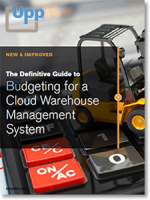Budgeting for a Cloud Warehouse Management System
A cloud WMS provides the flexibility to increase user capacity to match your natural spikes in production and demand, this increases agility throughout the calendar year allows you to pay only for the licenses you need, reducing your total cost of ownership.
What Makes Budgeting for a Cloud Warehouse Management System Different?
The cloud has fundamentally altered how you budget for a warehouse management system.
The lower up-front costs make the best technology more easily available to businesses of all sizes.
The most advanced cloud technology is available at dramatically reduced rates relative to previous business generations; you just have to take advantage of it.
Best of all, you’re only paying for what you use with a cloud-based WMS.
You can easily add or remove user licenses based on your growth or seasonal business spikes.
An on premise system can hold you back, but the cloud will never hold you back and will scale to grow with your business.
The 5 most important components of every budget
- Hardware Costs
- Software Costs
- Integration Costs
- An understanding of how it fits into your overall budget
- Getting talent to buy in
In this ebook, you’ll learn how to strategically plan your budget so your organization can run a more profitable supply chain.
What’s Related


Favorites





